Canon PowerShot A3400 IS review
-
-
Written by Ken McMahon
Intro
The Canon PowerShot A3400 IS is a 16 Megapixel compact with a 5x stabilised optical zoom and a 3 inch touch screen. Announced along with the rest of the 2012 PowerShot range in January it’s the first PowerShot with a touch screen, a feature normally reserved for the more expensive ELPH / IXUS models.
The A3400 IS features Canon’s ‘Intelligent IS’ stabilisation system and ‘Powered IS’ for eliminating wobbles during movie shooting. Its best quality movie recording mode is 720p at 25 frames per second and it can also film using Creative effects such as Miniature mode. It has a mono microphone for movie audio and a built-in flash.
Here I’ve compared the A3400 IS with the cheaper PowerShot A2300. Between them the A2300, A2300 IS and A3400 IS make up the mid-range of the 2012 A series sharing a similar body, control layout and features, with the A2300 IS providing the option of optical image stabilisation and the A3400 IS adding a touch screen. How important is optical IS and is a touch screen really worth the extra layout on what is essentially a budget point-and-shoot compact? Read my full review to discover the answers.
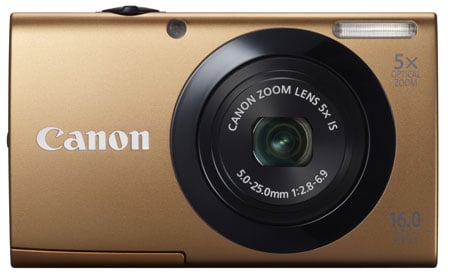 |
Canon PowerShot A3400 IS Design and controls
The styling of the 2012 PowerShot A series has grown closer to that of Canon’s up-market ELPH / IXUS range and along with its counterparts the A3400 IS looks more sophisticated and grown-up than earlier models. It’s a couple of millimetres taller and 1.2 millimetres wider than the slimmest PowerShot, the A2300 and weighs 16g more, but is still very pocketable. It’s available gold, red and silver.
Unlike the A2300, which has a coloured front panel with a black plastic rear, the A3400 IS is finished in an attractive two-tone scheme with a slightly darker back panel. My gold review model had a bronze coloured back. It’s interesting how much of difference this makes in terms of your perception of the camera, the A3400 looks unquestionably like a pricier camera and the slightly increased weight only adds to that feeling.
Despite the fact that it has a touch-screen, the control layout on the A3400 IS is exactly the same as on the A2300. There’s a four-way controller, Menu and Playback buttons, a dedicated movie recording button and a dedicated Help button that launches the on-screen help pages.
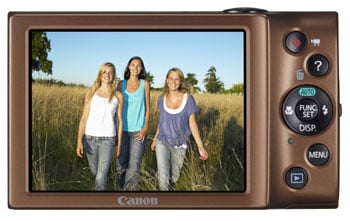 |
The A3400 IS’s 3 inch LCD touch-screen is clear and bright and suffers none of the viewing problems of the A2300’s which has a narrow viewing angle both horizontally and vertically. You can still see the A3400 IS’s screen with the camera held at 45 degrees arms length above your head.
Of course, the big difference between this screen and that of other PowerShots is that it’s touch-sensitive. I’ll talk more about how this affects handling and what additional features in more detail in the handling section. For now though, I’ll just point out that although the physical controls allow you to pretty much ignore the touch screen, if you’re going to do that you may as well save a little money and buy the cheaper A2300 IS. But even if you ignore the multitude of other functions it provides, the ability to focus and shoot by touching the screen, on its own makes the touch-screen worth having.
The A3400 IS has a built in flash unit situated on the top left of the front panel which unfortunately makes it easy to inadvertently cover with your index finger. It has a maximum range of 3 metres at the wide angle zoom setting and takes about four seconds to recycle between shots. Unusually for a point-and-shoot compact, Canon provides not one, but two optional flash attachments, the HF-DC1 and HF-DC2.
A door on the right of the bottom panel houses the slim NB-11L battery which provides enough power for 180 shots under CIPA (Camera Imaging Products Association) standard conditions. That’s on the low side, but it’s the price you pay for having a very small lightweight battery and and a power-hungry touch-screen. The SD card slot sits just behind the battery, the A3400 IS takes SD, SDHC and SDXC cards.
On the right of the camera body a small plastic door covers the combined USB and A/V out port. This takes a USB cable for transferring photos and video to your PC and can be used with the optional AVC-DC400 cable to connect the A3400 IS to a TV with a composite video port.
Canon P
owerShot A3400 IS lens and stabilisation
The PowerShot A3400 IS has a 5x optical zoom with a range of 28-140mm. With the exception of the top-of-the-range PowerShot A4000 IS, all the 2012 A series PowerShots share the same lens, though not all have optical image stabilisation. It’s an excellent 5x range for an all-round compact and goes just a little beyond the portrait zoom focal length at the telephoto end. If you shoot large landscapes, interiors or groups you may find the 28mm wide angle a little constraining, though if you want something wider you’ll have to look outside the PowerShot Range at something like the IXUS 125 HS which costs around twice as much.
Canon PowerShot A3400 IS coverage wide |
Canon PowerShot A3400 IS coverage tele | |
 | 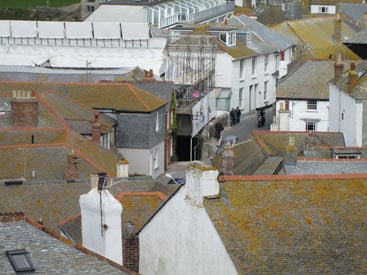 | |
| 5-25mm at 5mm (28mm equivalent) | 5-25mm at 25mm (140mm equivalent) |
The PowerShot A3400 IS has optical image stabilisation as indicated by the IS suffix in its name. Canon’s Intelligent IS analyses the scene and applies the most appropriate stabilisation, doing away with the need for panning modes that disable the stabilization in either the horizontal or vertical plane to allow you to follow subject movement. Intelligent IS on the A3400 IS has 6 modes and displays an icon to tell you when it’s in normal (2-axis) IS mode, panning mode, when it’s disabled because the camera is mounted on a tripod, macro mode, and the two movie stabilisation modes – Dynamic and Powered IS.
To test the optical image stabilisation on the PowerShot A3400 IS I took a series of shots in Program auto mode with the lens set to its maximum 140mm zoom range. With the light deteriorating I took shots at progressively slower shutter speeds with IS enabled and turned off. As you can see from the crops below, with Inteligent IS enabled, the PowerShot A3400 IS is capable of handheld shooting at speeds as slow as 1/13th of a second, a little more than three stops slower than convention suggests should be possible at this focal length.
Canon PowerShot A3400 Intelligent IS Off/Continuous | ||||
 | 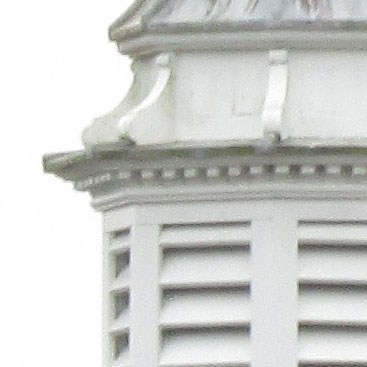 | |||
100% crop, 5-25mm at 25mm, 100 ISO 1/13th IS off. | 100% crop, 5-25mm at 25mm, 100 ISO 1/13th, IS Continuous. | |||
Canon PowerShot A3400 IS shooting modes
You choose the shooting mode on the A3400 IS by using the top button on the four-way controller. This toggles between Auto mode and either Program mode or whatever the current alternate shooting mode is. In Auto mode the Digic 4 processor uses scene detection to determine the best exposure. It works by dividing scenes into those that either do or don’t contain people, and determines whether there’s any subject movement before analysing the lighting conditions.
The Digic 4 can tell if the subject is backlit, spotlit, if there is blue sky in the frame and if you’re shooting a sunset. It can also determine if you’re shooting in the dark and whether you have the camera attached to a tripod. Finally it keeps track of focus as well as exposure so can tell if you’re lining up a macro shot. Put all that together and you have a system that capable of recognising 32 different scene types.
All of this works very smoothly in practice though the A3400 IS isn’t infallible. When it detects motion in the frame it automatically switches to tracking AF, but mere camera movement often fools it into doing this and it also occasionally gets the lighting conditions wrong. Ninety percent of the time though it works well and produces great results.
Switch out of auto mode and you have the choice of Program mode with control over ISO sensitivity, Exposure compensation, White Balance, and image size among other things. Novice shooters might feel more comfortable with Live View Control, which provides three sliders for control of exposure compensation (Dark/Light), saturation (Neutral/Vivid) and white balance (Cool/Warm).
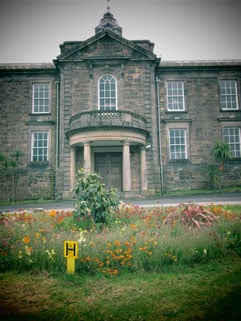 |
 |
 |
The usual Canon Scene modes are included as are what used to be called Creative effects – Miniature, Fish-Eye, Super-Vivid and, included above, Toy Camera, Monochrome, and Poster Effect. Also included is Canon’s Face Self-timer function which starts the countdown when a new face enters the frame, so you don’t need to make a dash for it.
Canon P
owerShot A3400 IS movie modes
The A3400 IS can shoot HD movies at 720p resolution with a frame rate of 24 or 25 frames per second depending on region. Movies are encoded at an average bit rate of 18Mbits/s encoded in the H.264 format and saved as Quicktime.mov files. The longest single clip recording time is a second shy of 30 minutes and Canon recommends using an SD card of Class 4 or faster.
None of the A series PowerShots has an optical zoom that functions during movie recording and all have built-in mono mics. They do allow use of some Creative Effects during shooting, though, the best of these being Miniature mode with speeded up playback at 5x, 10x, or 20x. These modes record at 720p HD resolution, but only if you remember to switch the still image resolution from 4:3 to 16:9 first, which is a convoluted way of doing things, and one which most people probably won’t even be aware of, as if you’re shooting at the default 4:3 shape for stills, the Creative Effects movie modes default to VGA (640 x 480).
Smart Auto with scene detection isn’t used for movie recording, but you can use both exposure compensation and Live View Control to alter exposure and colour settings prior to pressing the record button.
| |
|---|---|
|
Outdoors the A3400 IS’s 720p25 HD video looks good. Even at the 25mm wide angle setting, Intelligent image stabilisation keeps things nice and steady. Compare this clip with the video sample from the PowerShot A2300 (taken at a different time) to see the difference stabilisation makes.
| |
|---|---|
|
There’s not as much light reflecting off the water as is often the case in this scene and the CCD sensor in the PowerShot A3400 IS copes well, but the mono mic is quite prone to wind noise and there’s no wind cut filter.
| |
|---|---|
|
Once again the stabilisation works well to dampen wobbles in this hand-held panning shot. As on the PowerShot A3400 IS, the noise in this low light environment is quite visible.
| |
|---|---|
|
The A3400 IS can shoot video using some Creative Effects filters. Here’s Miniature mode with playback at 5x producing a twelve second clip from a minute’s worth of shooting. Other options are 10x and 20x. Once again, if the photo aspect ratio is set to 4:3, then these modes will record video at VGA 640×480 pixels, but if you set the photo aspect ratio to 16:9 before recording, the video will be recorded in 720p HD.
Canon PowerShot A3400 IS
handling
The Powershot A3400 IS is ready to take a shot about two and a half seconds after you switch it on. The single speed zoom covers the 5x optical range quickly and smoothly but also provides a good degree of nudge control. Auto focus is fast and accurate in most circumstances taking a fraction of a second from when you half-press the shutter to the confirmation double-beep. As I’ve already mentioned, the A3400 IS has a tendency in Smart auto mode to interpret camera movement as subject movement and it also occasionally gets it wrong with scene recognition, but most of the time it works so well you don’t have to think about it.
The touch screen can be used both to touch focus – tapping the screen at the relevant position focuses on that spot and activates tracking AF – or to focus and take the shot with a single tap. It has plenty of other functions depending on the shooting mode. In Program auto an icon appears in the bottom left of the screen for exposure compensation. Tap it and your provided with a scale and nudge controls, a much quicker and more direct method than on the A2300 where you must select the Func menu then scroll down to exposure compensation then use the left and right four-way controller buttons. Likewise for Live View Control the touch screen provides a very direct and intuitive interface. It also makes switching between shooting modes much easier, you just tap on the shooting mode Icon and choose from one of the options.
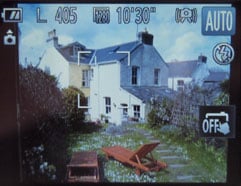 |
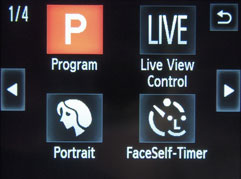 |
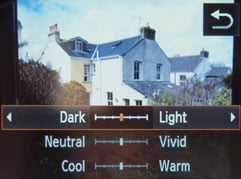 |
The touch icons are nice and big (arguably too big, needing four pages to accommodate all 16 shooting modes) and the screen is responsive. If I was to make one criticism it would be that the touch screen and physical button systems appear to be totally separate so you can’t switch mid operation from one to the other. For example, if you select exposure compensation using the control pad you don’t get the screen adjustment control, but have to continue in button mode. And there are some functions, for example ISO selection, that it would be nice to be able to touch select, even though you have to initiate them by pressing the Func shortcut button. But these are minor niggles, overall the touch features are a real asset to the A3400 IS.
Fast continuous shooting has never been a strong point for A series PowerShots and the A3400 IS has nothing new to offer with a top full resolution continuous shooting speed of 0.8 frames per second. If you select Low light mode you can capture high ISO 4 Megapixel shots at 3fps.
The PowerShot A3400 has a 16 Megapixel CCD sensor with a sensitivity range of 100 to 1600 ISO. Images have a maximum size of 4608 x 3456 pixels and are saved as compressed JPEGs with an average size of 3 to 5MB. The shutter speed range is 15 – 1/2000.
To see how the quality of the PowerShot A3400 IS measures-up in practice, take a look at my Canon A3400 quality and Canon A3400 noise results pages, browse my Canon A3400 sample images, or skip to the chase and head straight for my verdict.
 By simplifying the A Series line up around a common sensor and lens combination - 16 Megapixel CCD and 28-140mm 5x optical zoom (the 8x A4000 IS excepted), Canon has made the choice of which PowerShot to buy much easier for consumers. The A3400 IS is the touch screen model, if you don't want a touch screen its the A2300 IS and if you don't need optical image stabilisation it's the A2300. It's a bold move which reduces the options if you want, say, a wider wide angle, or a lower resolution sensor, but I wouldn't be surprised if it pays off in terms of increased popularity for A series PowerShots and the A3400 IS in particular. In the meantime, I feel the A3400 IS hits a sweetspot in terms of features and value, so earns our Highly Recommended award.
By simplifying the A Series line up around a common sensor and lens combination - 16 Megapixel CCD and 28-140mm 5x optical zoom (the 8x A4000 IS excepted), Canon has made the choice of which PowerShot to buy much easier for consumers. The A3400 IS is the touch screen model, if you don't want a touch screen its the A2300 IS and if you don't need optical image stabilisation it's the A2300. It's a bold move which reduces the options if you want, say, a wider wide angle, or a lower resolution sensor, but I wouldn't be surprised if it pays off in terms of increased popularity for A series PowerShots and the A3400 IS in particular. In the meantime, I feel the A3400 IS hits a sweetspot in terms of features and value, so earns our Highly Recommended award.



